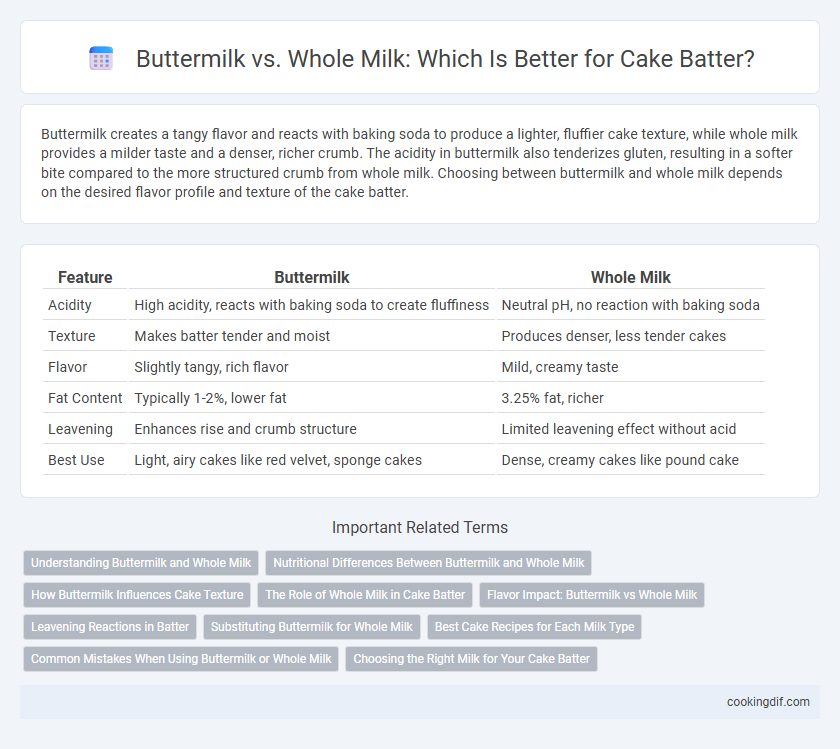Buttermilk creates a tangy flavor and reacts with baking soda to produce a lighter, fluffier cake texture, while whole milk provides a milder taste and a denser, richer crumb. The acidity in buttermilk also tenderizes gluten, resulting in a softer bite compared to the more structured crumb from whole milk. Choosing between buttermilk and whole milk depends on the desired flavor profile and texture of the cake batter.
Table of Comparison
| Feature | Buttermilk | Whole Milk |
|---|---|---|
| Acidity | High acidity, reacts with baking soda to create fluffiness | Neutral pH, no reaction with baking soda |
| Texture | Makes batter tender and moist | Produces denser, less tender cakes |
| Flavor | Slightly tangy, rich flavor | Mild, creamy taste |
| Fat Content | Typically 1-2%, lower fat | 3.25% fat, richer |
| Leavening | Enhances rise and crumb structure | Limited leavening effect without acid |
| Best Use | Light, airy cakes like red velvet, sponge cakes | Dense, creamy cakes like pound cake |
Understanding Buttermilk and Whole Milk
Buttermilk contains lactic acid that reacts with baking soda to create a lighter, fluffier cake texture, while whole milk provides moisture without altering the batter's pH. The acidity in buttermilk enhances the tenderness and subtle tang in cakes, making it ideal for recipes requiring leavening agents like baking soda. Whole milk's higher fat content contributes to a richer flavor and denser crumb, suitable for recipes where a moist, soft cake is desired.
Nutritional Differences Between Buttermilk and Whole Milk
Buttermilk contains fewer calories and less fat compared to whole milk, making it a lighter option for cake batter. It also has a higher concentration of lactic acid, which aids in tenderizing gluten and enhancing the cake's texture. Whole milk provides more calcium and vitamin D, essential for bone health, but its higher fat content can result in a denser crumb.
How Buttermilk Influences Cake Texture
Buttermilk's acidity reacts with baking soda, creating carbon dioxide bubbles that result in a lighter, fluffier cake texture compared to whole milk. Its thicker consistency adds moisture and density, producing a tender crumb with enhanced richness. Cakes made with buttermilk often have a subtle tang that balances sweetness and improves overall flavor complexity.
The Role of Whole Milk in Cake Batter
Whole milk in cake batter enhances moisture and tenderness due to its balanced fat and protein content, which supports the cake's structure while keeping it soft. The milk's natural sugars promote browning and flavor development during baking, contributing to a rich, golden crust. Unlike buttermilk, whole milk results in a milder tang, offering a neutral taste that pairs well with various cake recipes.
Flavor Impact: Buttermilk vs Whole Milk
Buttermilk imparts a tangy, slightly acidic flavor to cake batter, enhancing the depth and richness of the final baked good compared to the milder, creamier taste produced by whole milk. The acidity in buttermilk reacts with baking soda to create a tender crumb and subtle complexity, while whole milk provides moisture with a more neutral flavor profile. Choosing buttermilk over whole milk significantly influences the flavor intensity and texture of cakes, especially in recipes for buttermilk chocolate cake or red velvet.
Leavening Reactions in Batter
Buttermilk contains lactic acid that reacts with baking soda in batter, producing carbon dioxide bubbles that enhance leavening and create a lighter, fluffier cake texture. Whole milk lacks this acidity, resulting in fewer leavening reactions and a denser crumb when used alone. Incorporating buttermilk optimizes the chemical leavening process, improving rise and crumb structure in cake batters.
Substituting Buttermilk for Whole Milk
Substituting buttermilk for whole milk in cake batter enhances moisture and adds a tangy flavor that balances sweetness. The acidity in buttermilk reacts with baking soda, producing carbon dioxide bubbles that create a lighter, fluffier crumb. When replacing whole milk, use the same quantity of buttermilk or thin it slightly with water to maintain batter consistency.
Best Cake Recipes for Each Milk Type
Buttermilk adds tanginess and acidity, activating baking soda for tender, moist cakes like red velvet or buttermilk pound cake, enhancing crumb texture. Whole milk provides richness and moisture, perfect for classic vanilla or chocolate cakes with a denser, creamier batter that yields a soft and fluffy crumb. Choosing the right milk depends on desired flavor profiles and texture preferences to optimize cake recipes.
Common Mistakes When Using Buttermilk or Whole Milk
Using whole milk instead of buttermilk in cake batter often results in a denser texture because whole milk lacks the acidity needed to activate baking soda, which helps the cake rise. A common mistake is not adjusting the leavening agents when substituting buttermilk with whole milk, leading to improper chemical reactions and uneven crumb structure. Overlooking the moisture difference between buttermilk and whole milk can cause the batter to be too thick or too runny, affecting the cake's final softness and flavor.
Choosing the Right Milk for Your Cake Batter
Buttermilk's acidity tenderizes cake batter by breaking down gluten, resulting in a moist, fluffy texture, while whole milk provides a richer fat content that enhances flavor and crumb structure. Choosing buttermilk is ideal for recipes requiring a tangy taste and lighter crumb, whereas whole milk suits denser cakes with a creamy mouthfeel. Adjusting leavening agents can optimize rise depending on the milk used, ensuring perfect cake consistency.
Buttermilk vs Whole Milk for batter Infographic

 cookingdif.com
cookingdif.com